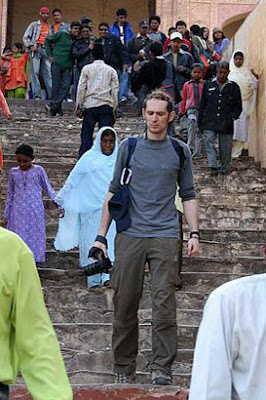Lets roll some spices on the spice tour
 MEMORABLOG: 1.12.1998
MEMORABLOG: 1.12.1998Over the centuries, Zanzibar’s cloves, nutmeg, cinnamon, pepper and many other spices brought the sultans of Oman across the Indian Ocean by dhow on the seasonal trade winds.
For 15 US$ dollars, a full-day Spice Tour was available. It was said that will introduce us to most of Zanzibar's spices and fruits, and not only that, we'll see a few historical sites - old slave market and cave, ruined sultan's palace, baths and if you are lucky, a few historical sites too - such as the old slave market or a ruined sultan’s palace.
Our tour was by dala-dala (pick-up trucks converted into buses) and included good lunch of traditional Zanzibar food. On a way towards the “core” fields of Spice tours we went past the Livingstone house. This was used by Europeans whilst starting their expeditions to the mainland, including David Livingstone in 1866. Next stop was Mtoni Palace, built back in 1840 by Sultan Seydi. It was from here that the Sultan built and controlled his great African Empire and there were over a thousand people associated with his court here, including the royal family, Arab and Swahili merchants, scribes, c
 oncubines, servants and slaves. Well, today you can just vaguely imagine its former grandness. The palace was abandoned by 1885 and quickly fell into disrepair and during was damaged during the first world war.
oncubines, servants and slaves. Well, today you can just vaguely imagine its former grandness. The palace was abandoned by 1885 and quickly fell into disrepair and during was damaged during the first world war.The exotic spices and fruits are grown in the plantations towards the middle of island and there’s ample opportunity to dazzle the senses as you taste and smell them and guess what they are. We walked through the maze of trees and the smells were exceptional. Lemongrass, ginger, cardamom and cloves were just a few of the highlights. Other spices include nutmeg, vanilla, tamarind, menthol and plenty more... Oh, the island was once the world's leading producer of cloves (3/4 of the total world supply) and the clove industry was the foundation of the golden age of Zanzibar. Suddenly a short rain came, and we had to hide… under giant leaves… I don’t even need to mention those unknown fruits that we tried on a way…
Next stop were "slave caves". It is reputed to have been discovered in the early 19th century by a slave boy working on the estate of a wealthy Arab
 plantation owner. The boy found the entrance whilst searching for a goat which had fallen into the cavern. As a source of fresh water, the discovery was a blessing and from that day Hamed’s slaves regularly collected water from the pool for use on the estate. According to a guide book there is no evidence that the cavern was ever used to conceal slaves after prohibition. Well, stories differ and to us slave caves were presented as a gruesome place "to store" slaves.
plantation owner. The boy found the entrance whilst searching for a goat which had fallen into the cavern. As a source of fresh water, the discovery was a blessing and from that day Hamed’s slaves regularly collected water from the pool for use on the estate. According to a guide book there is no evidence that the cavern was ever used to conceal slaves after prohibition. Well, stories differ and to us slave caves were presented as a gruesome place "to store" slaves.However, just a kilometre away is another cave, that was used for "hiding" slaves... Following the abolition of slave trading in 1873, Arab merchants were resentful of what they saw as British
 interference. Black-market prices for slaves shot up and a thriving illicit trade developed, aided at sea by loop-holes in the treaties and the inability of the British to effectively patrol the whole of the Indian Ocean. On land the trade was more difficult to conceal. So, these slave Chambers were constructed by an important slave trader of the time, to hide slaves in transit from the mainland to the Zanzibar plantations and export further afield.
interference. Black-market prices for slaves shot up and a thriving illicit trade developed, aided at sea by loop-holes in the treaties and the inability of the British to effectively patrol the whole of the Indian Ocean. On land the trade was more difficult to conceal. So, these slave Chambers were constructed by an important slave trader of the time, to hide slaves in transit from the mainland to the Zanzibar plantations and export further afield.The day finished on a nearby beach. Nice, and no jelly fish this time :) All in all, it was a really nice day and tour :)





0 Comments:
Post a Comment
<< Home